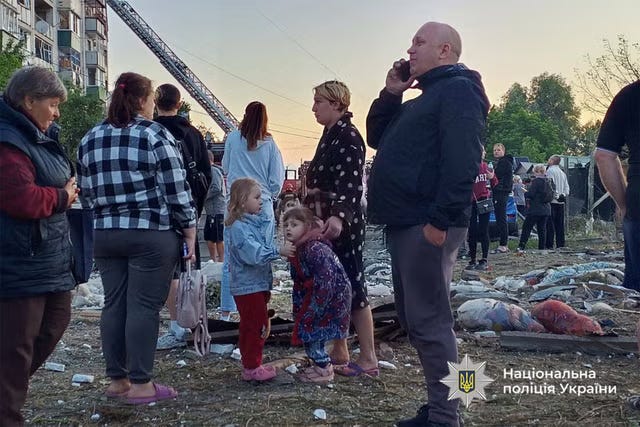Air Armageddon: Russia Launches Biggest Strike on Ukraine Since Full-Scale Invasion
Over 500 drones and missiles pound Ukrainian cities in a relentless overnight assault—forcing NATO to scramble jets and pushing the war into a dangerous new phase.

Russian forces launched more than 500 aerial weapons at Ukraine overnight in what was described as the biggest air strike on the country since the war began. “Almost all night long, air raid alerts sounded across Ukraine -- 477 drones were in our skies, most of them Russian-Iranian Shaheds, along with 60 missiles of various types,” Ukrainian President Volodymyr Zelensky said. He said Ukrainian pilot Maksym Ustymenko died “while repelling” Russian attacks. “Today, he destroyed 7 aerial targets,” Zelenskyy said. He praised Ukraine's air force for “heroically protecting our skies,” adding that he is “grateful to everyone who is defending Ukraine." Yuriy Ihnat, the air force's head of communications, told the Associated Press that the latest Russian assault was “the most massive air strike” on Ukraine since Russia’s full-scale invasion of the country began in February 2022. The attack prompted Poland and allied countries to scramble aircraft to ensure the safety of Polish airspace, the Polish military said on June 29. Casualties and damages were reported from at least six regions across Ukraine, including Lviv and Ivano-Frankivsk in the country’s west, Mykolayiv in the south, Zaporizhzhya in the southeast, and Poltava in central Ukraine - RFE/RL
According to the Kyiv Post, the assault included:
477 Shahed-type attack drones and decoy UAVs, launched from Russian territory and occupied Crimea;
4 Kh-47M2 Kinzhal hypersonic missiles from Russia’s Tambov region;
7 Iskander-M/KN-23 ballistic missiles from Voronezh region and Crimea;
41 Kh-101 and Iskander-K cruise missiles from Saratov, Kursk, and Bryansk regions;
5 Kalibr cruise missiles from the Black Sea;
3 S-300 guided missiles from Russia’s Kursk region.
Ukrainian President Volodymyr Zelensky signed a decree on Sunday to withdraw Ukraine from the Ottawa Convention, which bars the production and use of anti-personnel mines. Roman Kostenko, a member of parliament and military commander, said parliamentary approval will be needed to finalise the withdrawal, but called it “a step long demanded by the reality of war”. “Russia is not a party to this convention and uses mines extensively against our military and civilians,” he wrote on Facebook. “We cannot remain bound by restrictions when the enemy faces none.” - FT
A weakened Iran is unlikely to have much of an impact on Russia’s war effort, Hanna Notte, director of the Eurasia programme at the James Martin Center for Nonproliferation Studies, writes in the FT. That’s because Russia now produces vast quantities of Shahed 136 drones domestically, having received the production technology, blueprints and training from Iran. As Russia localised the production in its Alabuga Special Economic Zone, it span off variations from the original Iranian designs, improving the drones’ engines, warheads and resistance to jamming. She adds: “Similarly, Israel’s degradation of Iran’s missile production will have limited consequences. Last autumn, Russia received a batch of Iranian Fath-360 missiles and it has reportedly requested other models in the past. But it has not even used those Fath-360s in Ukraine. Ukraine estimates that Russia has stockpiled some 13,000 missiles of various ranges and can produce up to 200 per month. Moscow, it appears, has no acute need for Iranian missiles. The Kremlin has also branched out, forging new alliances. When it comes to Russian battlefield needs in Ukraine, reliance on Iran reached its zenith one year into the war, and has since been eclipsed by China and North Korea. In 2023, North Korea emerged as a critical enabler of the Russian war machine, sending munitions, missiles and — more recently — men…When it comes to sheer quantities of dual-use goods and weaponry components, China is the most important contributor to Russia’s defence enterprise. Indeed, as Russia reduced its reliance on Iran, it increasingly turned to China for parts. Ongoing construction of a Russian-Chinese logistics complex in Alabuga augurs a growing Chinese involvement in Russia’s drone production enterprise.”
VIDEO: Why Russian President Vladimir Putin has been having sleepless nights after the attacks on Iran. But it’s not great news for Ukraine️ at the end of the day, I told Times Radio of London
Heatwaves sweeping across Europe have pushed temperatures above 40°C in some countries. Authorities are urging caution as dry conditions, strong winds and heatwaves threaten wildfires. Several Italian regions are considering banning some work activities during the hottest hours of the day as a severe heatwave sweeps across the country, prompting red alerts in 21 cities by Sunday morning. Lazio, Tuscany, Calabria, Puglia and Umbria are among the regions planning to introduce the measure in response to soaring temperatures. The Italian Health Ministry placed 17 out of 27 monitored cities under its highest heat alert, including Rome, Milan and Naples. In Rome, tourists sought shade near the Colosseum and Trevi Fountain, some using umbrellas and drinking from public fountains to stay cool. Similar scenes were reported in Milan and Naples, where street vendors sold lemonade to help residents and visitors cope with the heat. Elsewhere in Europe, Spain’s national meteorological agency AEMET warned that June is on track to become the hottest on record, with temperatures in Seville and other southern cities climbing to 42°C. Experts attribute the increasing frequency and intensity of heatwaves in southern Europe to climate change. High temperatures were also reported across Greece and Portugal, with both locals and tourists seeking relief from the extreme weather - Euronews

Israeli attacks across Gaza have killed at least 45 people so far today, according to local medical sources quoted by our colleagues on the ground. Twenty-nine of the victims were killed in Gaza City or northern Gaza. Strikes have been particularly intense in Gaza City’s Tuffah neighbourhood and in Jabalia, where at least 10 homes have been destroyed, our colleagues reported. Meanwhile, there’s been nothing official from the Israeli prime minister, Benjamin Netanyahu, regarding the push for a ceasefire. Last week, he had said mediators were constantly talking to negotiators behind the scenes to try and secure a 60-day pause in the fighting - Al Jazeera
Iran could begin producing enriched uranium again in “a matter of months,” the head of the International Atomic Energy Agency (IAEA) said, as damage caused by U.S. and Israeli strikes on Iranian nuclear facilities was “severe” but “not total.” Iran clearly has the capacity to rebuild its nuclear facilities, Rafael Mariano Grossi, director general of the IAEA, the United Nations nuclear watchdog, said in an interview with CBS News. Grossi’s assessment that damage to Iranian nuclear sites was “not total” contradicted U.S. President Donald Trump’s claim that Iran’s nuclear facilities were “totally obliterated.” “They can have, you know, in a matter of months, I would say, a few cascades of centrifuges spinning and producing enriched uranium, or less than that,” Grossi said in the interview, which was conducted on Friday and is set to be broadcast on Sunday. Israel attacked Iran’s highly protected nuclear facilities with drones and warplanes in mid-June, aiming to prevent the regime in Tehran from building a nuclear bomb. The U.S. initially sought to stay out of the conflict, but waded into the fighting a week later by bombing key Iranian nuclear sites. The strikes have triggered counterattacks by Iran on Israeli cities and an American airbase in Qatar, although Trump announced a ceasefire between Israel and Iran last week. Questions remain over whether Iran moved its stockpile of enriched uranium prior to the strikes, and whether centrifuges remain intact at nuclear sites - Politico
A Chinese organization allegedly used a base in Japan to smuggle chemicals to make the synthetic drug fentanyl for the U.S., a Nikkei investigation has found. Nikkei reporters traced the shadowy trade in drug precursors from China to Mexico to the U.S. through the Japanese city of Nagoya. If Japan is part of a trafficking route, then the country could get caught up in the global frictions surrounding this issue, including the trade war - Nikkei Asia
Bellingcat and its partners at Kenya’s Daily Nation have identified Kenyan-labelled crates of ammunition inside an alleged RSF depot close to the recently recaptured Sudanese capital Khartoum. Although the investigation couldn’t independently verify the contents of every crate identified, tins with ammunition matching the labels on the crates were found nearby among the captured weapons displayed by the Sudanese Armed Forces (SAF). The confirmation of ammunition crates inside Sudan raises new questions about Kenya’s involvement in the conflict following a high-profile visit by Rapid Support Forces leader General Mohamed Hamdan Dagalo to Nairobiearlier this year. In response to the visit, the Sudanese government banned all imports from Kenya amid a perception of close ties between the Ruto government and General Dagalo, widely known as Hemedti. The Kenyan government defended the decision to host Hemedti, stating that their aim was to promote dialogue and peace and emphasising the importance of engaging all parties involved in the conflict. The Daily Nation reached out to the Ministry of Defence (MoD) of Kenya to ask about the crates we identified and how they ended up in Sudan. It also asked whether it was Kenyan government policy to supply ammunition or weapons to the Rapid Support Forces and how this comports with the government’s public commitment to facilitating peace and dialogue in Sudan. In its response, the Ministry of Defence said it did not recognise the crates or labels on them and distanced itself from the allegations. Its answer appears to be limited to nationally produced ammunition only as well as internal protocols. It didn’t mention if Kenya has done any imports, international transfers or diversions of the weapons or ammunition in question. A statement that leaves key concerns about the Sudan connection unclear.
France has struggled to kick its smoking habit, but a new public health decree published Saturday aims to change that. In the coming days, smoking will be banned in all French parks and sports venues, at beaches and bus stops, in a perimeter around all schools, and anywhere children could gather in public. In a country where smoking has for generations been glamorized in cinema and intertwined with the national image, government crackdowns on tobacco use have met resistance. “In France, we still have this mindset of saying, ‘this is a law that restricts freedom,’'' Philippe Bergerot, president of the French League Against Cancer, told the Associated Press. The ban aims ’’to promote what we call denormalization. In people’s minds, smoking is normal,’' he said. ’’We aren’t banning smoking; we are banning smoking in certain places where it could potentially affect people’s health and ... young people.’' - AP





Claire, the MSM in the US is controlled by the Trump regime, as you know. So, it's no surprise you saw little or nothing about Russia's despicable and illegal attacks on Ukraine. Moreover, the regime's "flood the zone" strategy is quite effective in limiting coverage of certain events. A great many Americans are aware and DO CARE about Ukraine. We are simply overwhelmed and focused primarily on fighting for democracy here at home.
Claire -- thank you for providing further details about this barbaric attack. (At the same time, in fairness, this was a front-page story on the NY Times site yesterday: https://www.nytimes.com/2025/06/29/world/europe/russia-ukraine-war.html.)